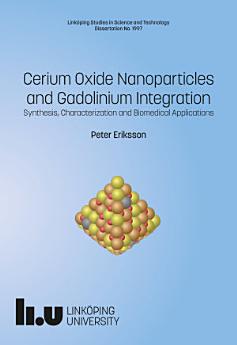Cerium Oxide Nanoparticles and Gadolinium Integration: Synthesis, Characterization and Biomedical Applications
เกี่ยวกับ eBook เล่มนี้
Small sized cerium oxide nanoparticles have electronic structures that allows coexistence of oxidation states 3+ and 4+ of cerium, which correlates to applicable redox reactions in biomedicine. Such cerium oxide nanoparticles have recently shown to exhibit antioxidant properties both in vitro and in vivo, via the mechanisms involving enzyme mimicking activity.
This PhD project is a comprehensive investigation of cerium oxide nanoparticles as scaffold materials for gadolinium integration. Gadolinium is well adopted into the crystal structure of cerium oxide, enabling the combination of diagnostic and therapeutic properties into a single nanoparticle. The main focus of this thesis project is to design cerium oxide nanoparticles with gadolinium integration. A stepwise approach was employed as follows: 1) synthesis with controlled integration of gadolinium, 2) material characterization by means of composition crystal structure, size, and size distribution and 3) surface modification for stabilization. The obtained nanoparticles exhibit remarkable antioxidant capability in vitro and in vivo. They deliver strongly enhanced contrast per gadolinium in magnetic resonance imaging, compared to commercially available contrast agents.
A soft shell of dextran is introduced to encapsulate the cerium oxide nanoparticles with integrated gadolinium, which protects and stabilizes the hard core and to increases their biocompatibility. The dextran-coating is clearly shown to reduce formation of a protein corona and it improves the dispersibility of the nanoparticles in cell media. Functionalization strategies are currently being studied to endow these nanoparticles with specific tags for targeting purposes. This will enable guidance of the nanoparticles to a specific tissue, for high local magnetic resonance contrast complemented with properties for on-site reduced inflammation.
In conclusion, our cerium oxide nanoparticles with integrated gadolinium, exhibit combined therapeutic and diagnostic, i.e. theragnostic capabilities. This type of nanomaterial is highly promising for applications in the field of biomedical imaging.







